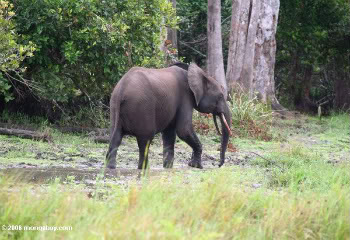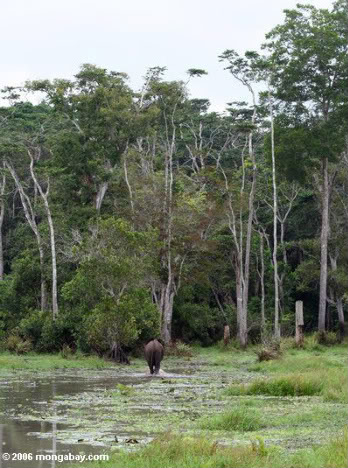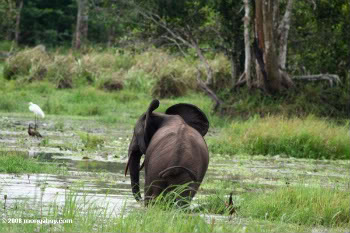|
|
A new study finds that forest elephants may be responsible for planting more trees in the Congo than any other species or genus. Conducting a thorough survey of seed dispersal by forest elephants, Dr. Stephen Blake, formerly of the Wildlife Conservation Society (WCS) and now of the Mac Planck Institute for Ornithology, and his team found that forest elephants consume more than 96 species of plant seeds and can carry the seeds as far as 57 kilometers (35 miles) from their parent tree. Forest elephants are a subspecies of the more-widely known African elephant of the continent’s great savannas, differing in many ways from their savanna-relations, including in their diet.
“Forest elephant diet is adapted to life in the forest with fruit consumed in large quantities, with browse making up a large proportion of the diet. By contrast, savannah elephants are primarily grazers and browsers,” Blake said.
 Forest elephant in Loango National Park, Gabon. The smaller size, downward tusks, and rounded ears differentiate this animal from savannah elephants. Photo by: Rhett A. Butler. |
This consumption of a wide-variety of fruits is what allows forest elephants to be such effective seed dispersers. While the researchers—including Blake, Eric Mossimbo and Fiona Maisels of WCS, Sharon Lynn Deem of the Whitney Harris Center and Wildcare, and Peter Walsh of the Max Plank Institute for Anthropology—found that forest elephants dispersed 96 different species of plants from 36 families, the actual number of seeds is far higher since the scientists did not take into account seeds smaller than a centimeter, though such seeds were estimated to appear in the hundreds or even thousands in many of the dung piles.
As important as the variety of seeds dispersed by forest elephants for the structure of the Congo’s forest is the distance the elephants carry their seed-quarry. Previously, the scientist James Powell had found that the rate at which seeds passed through the elephant depended on the size of seeds, small seeds passed in 24 hours, while the largest seeds took up to 72 hours. Blake’s team used GPS telemetry to track forest elephants and found that elephants moved as far as 24 kilometers in as many hours and 57 kilometers in 72 hours. “Thus long-distance movements are not rare events for forest elephants, but occur on a daily basis” the authors concluded.
Forest elephant’s amazing capacity to carry a variety of seeds far and wide leave other species in the dust. A study of primate seed dispersal in the Dja Forest of Cameroon found that all the primate species combined carried a total of 125 plant species, only 29 more than forest elephants. This finding also included smaller seeds, not counted by Blake and his team.
 Dwarfed by the trees, some of which its ancestors may have planted, a forest elephant moves away in Loango National Park, Gabon. Photo by: Rhett A. Butler. |
“It’s fair to say that forest elephants probably disperse more seeds than any other species, genus, or possibly even family of vertebrate dispersers, and they disperse seeds over unprecedented distances,” Blake told Mongabay.com. Forest elephants also outstripped all other species, including birds, in their ability to carry seeds the furthest. The researchers point out that 57 kilometers, the furthest an elephant was shown to roam before passing seeds, was 8 times the distance large hornbills spread seeds.
Blake has studied the enigmatic and shy forest elephants for over ten years, using GPS collars he tracks them through the dense forests of the Congo. For this study, however, Blake and colleagues were not so interested in finding elephants as their dung piles. To uncover the number and variety of seeds dispersed the team studied a total of 855 elephant dung piles.
While considerably smaller than savanna elephants, forest elephants are the world’s largest forest-dwelling animals. And though they differ from their savanna cousins physically, including straight tucks pointed down and rounded ears, they are also unique in their behavior. “They live in small social groups of a female and her offspring, or 2 females and offspring, while savanna elephants live in considerably larger group,” Blake said.
Forest elephants are so markedly different from savanna elephants that a study in 2001 concluded that they should be considered a different species entirely. Blake says there is merit to such an argument, “I am not a geneticist or a taxonomist so its hard for me to have a strong opinion, however I see some very considerable ecological, social, physical and behavioral differences between the taxa which suggest the species may be separate.”
 A forest elephant shows its threatening side. Photo by: Rhett A. Butler. |
The conclusion has been widely debated, but currently the IUCN African Elephant Specialist Group holds that the forest elephants is a subspecies and not a wholly different species.
Rather subspecies or species, it doesn’t change that forest elephants are on the brink. They have been devastated by logging, and the ivory and bushmeat trades. Slaughtered en masse by the ivory rush of the late-19th Century, forest elephants are still in decline. In the 1980s there was estimated to be 170,000 individuals in thee wild, but the population is believed to have dropped precipitously since then. A recent survey of elephants in the Democratic Republic of Congo showed a decline of 80 percent in 50 years. While such statistics may give an idea of the forest elephants, Blake cautions that “no one really knows” how many elephants are left.
“Hunting for ivory is the major threat facing forest elephants, which is facilitated by logging road development. The illegal ivory market is booming,” Blake said. “We are witnessing the annihilation of the forest elephant at a time when the popular dogma is that African elephants are no longer threatened.”
The effectiveness of forest elephants as seed dispersers, essentially engineers of the forest, adds further urgency to the need for their conservation. Without elephants, the great tropical forests of the Congo will undergo drastic transformation.
“An elephant poaching pygmy friend told me years ago that if the elephants go, the forest will die,” Blake said. “It might not be quite as dramatic as this, but the loss of forest elephants on the functionality of central African forests might be comparable to the loss of all vehicles for the functionality of Manhattan. It would be a radically different place.”
 Retreating into the swamp, even in protected areas the forest elephant is threatened by the ivory trade. Photo by: Rhett A. Butler. |
Trees that rely on elephants for dispersal, including many species with large seeds, are likely to dwindle. Some may even follow the elephants into extinction. While the paper highlights that other seed-dispersing species may be able to make up for some of the loss of elephants, it points out that the elephant’s have a unique place in carrying especially large seeds and carrying them far.
In addition, the loss of elephants “is not an isolated event,” the authors write, “ rather it is the herald of imminent or simultaneous declines in numerous other species of large-bodied seed dispersers to supply the burgeoning bush meat trade. Commercial hunting for ivory and meat will result in a cascade of
mammalian extinctions or near-extinctions over vast areas of the Congo Basin, and bring with it the potential for a major wave of tree recruitment failure.”
With steady declines across their range, Blake does not believe forest elephants can survive without greater conservation measures.
“Tell [your readers], that it is the last hurrah for forest elephants,” he said.
Related articles
Elephants populations in the Congo drop 80 percent in fifty years
(03/11/2009) According to the conservation organization Wildlife Direct , Wildlife Direct a recent survey of elephants in the Democratic Republic of Congo reveals that populations have dropped 80 percent in fifty years. The survey was conducted by John Hart using forest inventories, aerial surveys, and interview with local peoples.
Forest elephants learn to avoid roads, behavior may lead to population decline
(10/27/2008) Forest elephants in the Congo Basin have developed a new behavior: they are avoiding roads at all costs. A study published in PLoS One concludes that the behavior, which includes an unwillingness to cross roads, is further endangering the rare animals which are already threatened by poaching, development, and habitat loss. By avoiding roads, the elephants are increasingly confining themselves to smaller areas lacking enough habitat and resources.
African elephants being poached at record rate
(08/01/2008) African elephants are being killed for their ivory at a record pace, reports a University of Washington conservation biologist.
Disappearance of elephants, giraffes causes ecological chain reaction
(01/10/2008) The disappearance of elephants, giraffes and other grazing animals from the eastern African savanna could send ecological ripple effects all the way to the savanna’s ants and the acacia trees they inhabit, warns a new study published in the journal Science.
African elephants get 9-year reprieve
(06/14/2007) African countries have agreed to extend a ban on ivory exports for another nine years. In a deal reached Wednesday at the meeting of the UN Convention on International Trade in Endangered Species (CITES) in The Hague, four African countries will be allowed to sell their ivory stockpiles to raise funds for conservation and community development efforts. The ivory had been intercepted from black market transactions and the sale by Botswana, Namibia, South Africa and Zimbabwe had been previously approved. The four countries say their elephant populations are increasing thanks to conservation and law enforcement efforts.
Congo forest elephants declining from logging roads, illegal ivory
(04/02/2007) Fast-expanding logging roads in the Congo basin are becoming ‘highways of death’ for the fierce but elusive forest elephant, according to a new study published in the journal Public Library of Science. Logging roads both provide access to remote forest areas for ivory poachers and serve as conduits of advancing human settlement.
When elephants attack. Surviving an elephant charge in the Congo rainforest of Gabon
(06/26/2006) The elephant charges. The ground trembles. Hearts racing, we are now sprinting through the forest dodging vegetation as the elephant plows right through it. The problem with being chased by an elephant, aside from their obvious size advantage, is they can run faster than you. While wild elephants can be dangerous animals under the right circumstances, other creatures are responsible for more deaths in Africa. Topping the list is the hippo, whose penchant for capsizing canoes that come too close results in the dumping of passengers who often can’t swim. Buffalo, crocodiles, and lions are directly responsible for more deaths and injuries.